Henry Diltz started as a folk musician snapping his friends and became one of the foremost music photographers of the 1960s, having snapped The Doors, The Byrds, Buffalo Springfield, The Monkees, Jimi Hendrix, The Mamas and The Papas, Joni Mitchell, Neil Young and Crosby, Stills and Nash.
His pictures include iconic album covers of that period, such as The Doors’ Morrison Hotel and Crosby, Stills and Nash’s eponymous debut album.
A new DVD, Legends of The Canyon, tells the story of that scene, featuring interviews from those who were around at the time, including Diltz himself.
We (Trebuchet’s Sarah Corbett and Carl Batson) interviewed Henry Diltz at Soho’s Gibson Rooms. Fascinated by the small fridge full of cans of mixed Jack Daniels and Coke, Diltz exclaimed, “It can’t really be whiskey and Coke!” before trying one and confirming that indeed it was.
Buzzing with enthusiasm and positivity, he retains the long, hippy ponytail and large grin of his youth and exudes a love of photography, genuine interest in people, and fascination with life itself.
So Henry, if the 1960s was all about love and peace, where did everything go wrong?
Charles Manson is where it all went wrong and coke, I think. 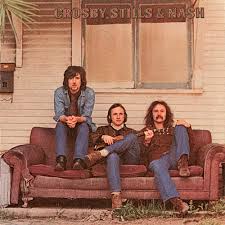 You know back in the early days when we were trying to expand our consciousness by taking psychedelics and smoking flowers, we were interested in expanding our senses and it was good for music and it was good for photography. Life was opening up in a new way back then in the middle 1960s and we all felt that there was a surge in the air of peace and love and brotherhood. We had love-ins in the park and everybody dressed up beautifully.
You know back in the early days when we were trying to expand our consciousness by taking psychedelics and smoking flowers, we were interested in expanding our senses and it was good for music and it was good for photography. Life was opening up in a new way back then in the middle 1960s and we all felt that there was a surge in the air of peace and love and brotherhood. We had love-ins in the park and everybody dressed up beautifully.
As my peers got older, I know what happened for me was that I got married, had kids and moved out of Laurel Canyon and that’s what happened to a lot of those early people. People say, where did that hippy generation go? Well I think it went into things like Greenpeace and awareness of the planet – save the planet, save the polar bears, save the whales, that kind of thing. I mean, I think those hippies grew up and had kids and hopefully educated them in the gentler outlook on life.
But there is greed in the world and selfishness unfortunately. We come down on this earth to learn lessons, you know, this is like the sandbox where we have to learn these things. If we knew it all, we wouldn’t have to be here so maybe these are the lessons that we have to learn. But will we get it all together at some point? I really hope so.
They say it’s the Age of Aquarius, we’re supposed to have accelerated awareness, which is what we always wanted and hopefully that will happen.
In the DVD, it’s very clear that you differentiate between drugs that have a positive effect on people and those that have a negative effect.
Yes, when the groups got enough money to afford the more expensive drugs, unfortunately the white powders, those are really dead end, those kill your brain cells rather than open your mind up, that did happen. Some of that happened to my friends. I’m glad I never really got into it myself because I really wanted to know more, I didn’t want to shut down. You just spin your wheels on those kinds of drugs or you just pass out.
Manson really was a big turning point because after Charles Manson and those hideous killings, you really couldn’t stop and pick up someone with long hair hitch hiking because they might slit your throat. No one ever imagined that happening or thought of that, it wasn’t even within the realm of possibility until it happened and then you had to think about it. So that was a terrible thing.
I don’t want to get all spiritual now but there is a universal force and if you really believe in it then it’s in everything, so everything happens for a reason. Maybe we were learning too much, maybe we were getting too cool and there had to be some kind of a downturn, it’s got to go up and down, we’ve got to keep learning. But as has been said, even the bad things are good because there are no problems, only opportunities to learn.
Was Manson ever involved in your social circle?
No, no, I know he was around Hollywood and a few of my friends met him, he was a wannabe songwriter, but no, I never met him, never saw him.
Given that you recorded some private moments, did you ever feel any tension between your role as a photographer and your friendship with the people you were photographing?
No, not really, because they were all friends of mine first of all and I was allowed in there because I was a fellow musician and a friend. I wasn’t an obtrusive photographer; I didn’t wade in clicking away. I sat there and waited until the moment looked right, a kind of fly on the wall, and would surreptitiously take the photo.
I started as a musician, when I picked up a camera by accident and had a wonderful time showing slides that I did and I thought, these look so great, I want to take more slides. The thought wasn’t: “I want to be a photographer”. The thought was just, “I want to get more slides because these slide shows are a hell of a lot of fun”.
So I photographed all of my friends and one of my greatest pleasures was showing pictures of them to themselves on the weekend that I’d taken during the week. One of my favourite things was when they’d say, “Oh my god, I didn’t even know you took that!” And that was my thing; I liked to just sit very quietly.
Still to this day now, instead of having Nikon film cameras, I have a little pocket Canon. One of my favourite things is to sit in a restaurant and take close-ups of people around me at the other tables when they don’t know it.
Carl: Do you find people object more these days?
They don’t know! They never know. I went to the park, to Green Park yesterday and took a hundred pictures of people laying on the lawn, pretty girls and all this stuff going on.
So I’ve had a succession of these little pocket cameras. This one zooms twenty times. The thing I didn’t know when I bought it is when you zoom way out, the thing goes, woooo [shows us the lens coming out] so it’s a little hard to be surreptitious, but you just aim it at somebody and then you look away and push the button. You’re not looking at them, you’re just, click. Nobody ever sees me take their picture.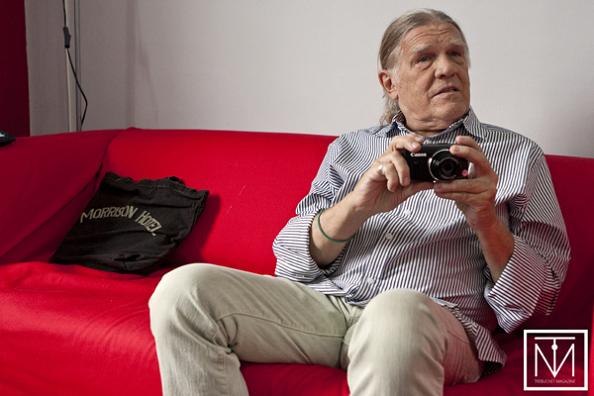
You’ve caught some great spontaneous moments on film – I particularly like your shots of the dog in the car and the girl at the petrol station. Are you constantly on lookout for photos?
Yeah, I constantly take pictures. It’s the act of taking the picture that’s pleasurable to me and good things come out of it but I love taking them. It’s all about balance. Framing, somebody said I have a framing Jones and I do. I like to frame the world; it’s kind of a little art thing to do.
Just walking down the street I’ll take twenty pictures. I love to photograph stuff on the sidewalk – the manhole covers or spots on the sidewalk or whatever it is, or signs on the phone poles or graffiti or license plates of cars. Anything, just all kinds of stuff.
Coming to a new city like London, it’s fantastic because it’s all fresh new stuff. It’s kind of a holdover from the old slide shows that I did. I never project these anymore, I collect them and I’m going to make books out of them. When I entertain my friends, after several months of photographing them and laying the slides out, you have to lay them out in some kind of order.
The editing is part of the fun when you start with something really colourful, something that you go, oooh wow, and then get into a series of things. I noticed that I had three or four pictures of my friends reading magazines during any given week, or eating or taking a nap, some of my friends like to fall asleep and I take a picture of them. So then I’d put three or four shots and call it the Eating Series or the Sleeping Series or the Reading Series.
Then I went out on the road with The Lovin’ Spoonful and we went all over the Midwest and every little town we went in had a different colour fire hydrant. You think of fire hydrants in America as red but there aren’t that many red ones. In LA, they’re all yellow, in San Francisco they’re light blue and white, In New York they’re black and silver, in the Midwest they’re green, they’re purple, they’re yellow, orange, every colour, every colour combination.
[quote]I still shoot numbers,
I shoot numbers every
day whenever I
see a great number
because it might
be better than
the 29 that I have[/quote]
So as soon as we’d get to a motel, I’d run out to the corner, get down on my knees and photograph the fire hydrant. My first big series was fire hydrants, outside of eating, sleeping and reading.
Then we would have these slide shows and I would show four or five rolls and they would say, more, more, we want more! So I started doing numbers: 1, 2, 3, 4, 5, only they would have to be cool, like I don’t see the 9, oh there it is on the dog’s collar. I had a paper in my wallet that said ‘I need 73, I need 89 and I need 94’. Finally I got them all and now 40 years later, I still shoot numbers, I shoot numbers every day whenever I see a great number because it might be better than the 29 that I have.
I probably have ten or twenty of every number now but still I do it.
I photograph t-shirts and I photograph tattoos and I photograph graffiti and people giving the peace sign and people giving the finger. David Crosby was always giving me the finger. I have a hundred people giving me the finger and that’s fun to do on a slide show!
I love to photograph stars on things. I got to Pret A Manger and on top of the teacup, on the plastic cover, there’s a star and I photographed that yesterday. I have probably a thousand star photographs. Hearts is another thing and old cars, old trucks, flowers, babies, animals, people with animals, nudes, every photographer loves to take the lovely female form.
So all of these, I consider them categories that I collect. I’m a Virgo and Virgos analyse and they’re very list making and compartmentalising so I think of things in that way, they’re compartments of different kinds of photos. And landscapes and sunsets and all the normal things. There are about fifty actual categories.
Now 45 years later, I want to do books of all these things. Fifty books, each with a series, fifty little books with fifty stars and so on. I was going to do a hundred, I was going to call it Henry’s Hundreds but then I made up some little online books and a hundred is a few too many, you get a little bored you know, so maybe it’ll be forty or fifty or sixty of each thing.
T-shirts I love, I’ve made up a little mock up of a book of t-shirts and that was fun.
Do you prefer to catch people off guard?
Definitely. I love to do it off guard because I like candid photography. I don’t do studio photography with lights and a backdrop where it’s, “Ok give me that smile”.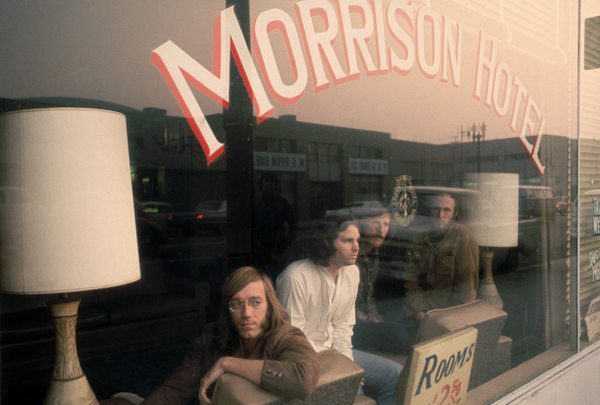
Carl: Have you never done studio photography?
I mean, I have once or twice, where somebody needed that. I’ve never had a studio, I’ve had to borrow somebody’s but no, I hardly ever, ever, ever, do that. It’s always natural light. I never went to photo school so I didn’t know about lighting or any of that and I didn’t care about it because what I saw was what I wanted to get, so yeah, candids, I love candids.
Now then on the other hand, if you’re a photographer, people say, “Oh I need a head shot”. I used to marvel about that because I’d get a call saying, “So and so gave me your number, I need a head shot”. I’d never met them before. So I go on over to their house and now, I’ve just met this person and I have to make them look the way I think they look the best. It’s kind of cool though because I don’t know them so that doesn’t influence me, it’s just purely visual.
So usually when I’m going to photograph somebody we sit down at the kitchen table and talk for a few minutes and while we’re talking, I’ll just pick up my camera and take a picture. We’ll just be talking and I’ll be, oh yeah that’s really cool you know (he clicks the camera in his hand) and take a picture. Then it relaxes them and it’s not like, “Ok let’s take pictures now,” and they go, “Oh shit I don’t know what to do”. I’ve already done it so there.
I’m taking pictures of you guys now!
Do you feel that you’ve captured the essence of your subjects?
I try to capture the essence of them. I like to just look through the lens or sit and wait until it’s right, both ways. Jane Goodall, the famous lady who watched the chimpanzees in the forest and made notes and how she didn’t want to interfere in what they were doing because she wanted the natural thing – same thing with me and rock groups. I wanted to photograph what they were really doing.
I didn’t want to say, “Ok stand over there, put that garbage can on your head”. I didn’t want to make up anything; I wanted to photograph the real thing so I would wait. Sometimes they say it’s the pictures you don’t take that really lead to the good pictures.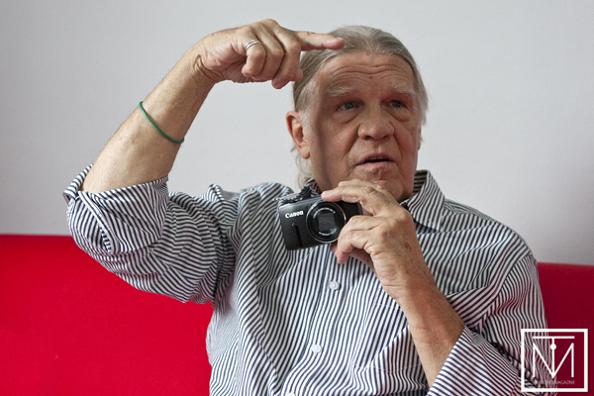
One time I had to go and photograph the Red Hot Chilli Peppers. I didn’t really know them, but the record company said, “Just go in the dressing room and shoot”. So I walk in and as soon as you walk in, everybody looks and everything stops and I say, “I’m just here, ok”. So I sit on the couch and I don’t do anything and after a few minutes they forget I’m there and then I can just get the pictures. That’s the way you have to do it.
Very often the people I photographed were people I knew because I was in the folk music thing and Neil Young and Mama Cass and Dave Crosby and Stephen Stills, around all these people I sort of knew from the Troubadour Club and from the folk days. I knew Jim Morrison as a fellow musician long before I ever picked up a camera so I already knew most of the people. It wasn’t very often I’d get someone else.
Going off with The Rolling Stones when I didn’t know them, that didn’t happen too often. Although I never went on the road with The Stones, Ron Wood did a solo album and he had to go on the road to publicise it, so he formed a little band with Keith Richards in so I got to go with that because friends of mine at the record company said, “You know you should go”.
So three weeks I was on the plane and on the road with them and I’m not a pushy guy so I’m probably not going to get kicked off the tour because I’m never going to do anything that’s going to piss anybody off. I’m very quiet and very patient and very positive and optimistic. So they grew to accept me and not even notice me. When they were dancing around in the dressing room and getting ready for a concert I’d be there quietly, like Jane Goodall. Once the chimps knew that she wasn’t going to hurt them then she could sit there all day.
You must have learnt a lot about band dynamics from observing.
Before I became a musician I was studying psychology at a couple of colleges but I ended up at the University of Hawaii. I majored in psychology, not that that taught me anything so much but it was more that I was so interested in people and studying them because I love people.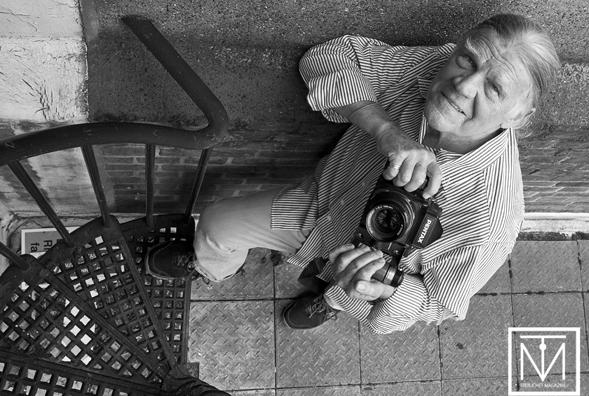
Then I was a musician then when I became a photographer, it was another way of observing people because being a photographer sometimes is like having a passport into somebody’s life where you wouldn’t ordinarily be. It was just another good vantage point to watch people and to have a reason to be sitting there in the dressing room with the Red Hot Chilli Peppers, otherwise why would you be there? So I always found that very interesting.
More than just band dynamics, it’s like, what are people like? God made us all so different and hoped we would share, that’s the thing. The whole concept of what am I, why am I here, what is this experience? We’re souls in these robots, fleshy robots. All of that really has always been something I’ve been curious about.
You know back in the ‘60s when we took psychedelics to try to answer some of these questions, we took it and realised there was so much more going on. Jerry Garcia from The Grateful Dead, there was a famous thing he said, “The first time I took psychedelics I thought, aha I knew there was more going on than they were telling us”. And that’s the idea because if you take psychedelics you say, “Oh my gosh. I thought life was just this ordinary thing but there is so much more to it,” you know?
It’s such an amazing thing and I think throughout your life, more and more you learn about how amazing life really is. So all of that comes into play when I’m around people.
I love to observe people whether it’s a rock group or not. I’m comfortable around rock groups because I was in a group. We travelled all over the country and spent weeks in vans and motorhomes and backstage and airports and you learn how to hang out as a musician because musicians hang out. They play for an hour in the evening and the rest of the time they’re hanging out, so it’s easy for me to hang out, sit backstage for a couple of hours and just cool it and see what’s going on.
Whereas I think people from photo school, they’re concerned about taking that photo – ok, I’m here, I’m going to get the photo – and they’re not used to just relaxing and hanging out and waiting. They’re anxious to do their thing.
What about live gig photos?
In the early days in live shows, I would worry about that a lot. I would think, “Well I need a photograph from the left, from the right, from the back of the room, from backstage”. I’d want to get everywhere and get every shot. But then as time went on, I realised that really the shot they’re going to want is sort of from the waist up, playing a guitar so if I just get in that one spot and just squat there with a telephoto and just look and when it looks perfect then I just push the button. So it’s a learning process, I guess.
It’s kind of a limited thing when you’re shooting on stage, I don’t do it so much any more. I’ve done that so many times that it’s not as much fun for me any more, although it’s great to have the best seat in the house right up the front! Sometimes it’s a little too close and you’re looking straight up. I’ve certainly done that probably thousands of times, now I just prefer taking pictures on my own, just what I like to photograph.
But I do get calls from groups. In the late 60s I was photographing brand new groups – I did the first Eagles cover, the first CSN cover, the first Jackson Browne cover. Their records hadn’t even been out yet. So nowadays I do the same thing. A group will call me up and say, “So and so gave us your name, we’ve got a group, we’ve recorded something, we have no pictures,” and I say, “Yeah, great, I’ll come over and talk to you guys and take some photos”.
Once again in the early days, I would worry about that. I would think, “Oh god, there’s seven guys in the group – how am I going to do that?” So I would rip out pictures from magazines and newspapers on groups and think, “If there’s seven guys, ok you could get on a ladder and look down or you could have four guys at the front and three guys behind,” and the various ways you could do it and I would worry about it.
Now I never worry about it because no matter what your plan, it’s going to be different anyway. You just go there and let the universe figure it out, you go there and something happens and you do it. If you have no ideas, someone there will have an idea. You’ll say, “Oh wow look at that staircase,” or something like that. So you have to just go there in a kind of a Zen way and just let the universe dictate what happens, just be ready.
Interview continues next week.
Henry Diltz portraits by Carl Byron Batson

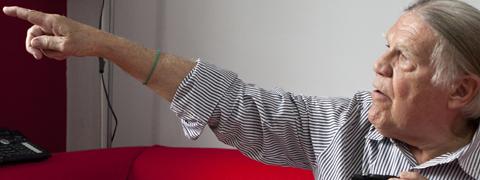




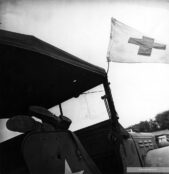














I really enjoyed this interview. Sage advice